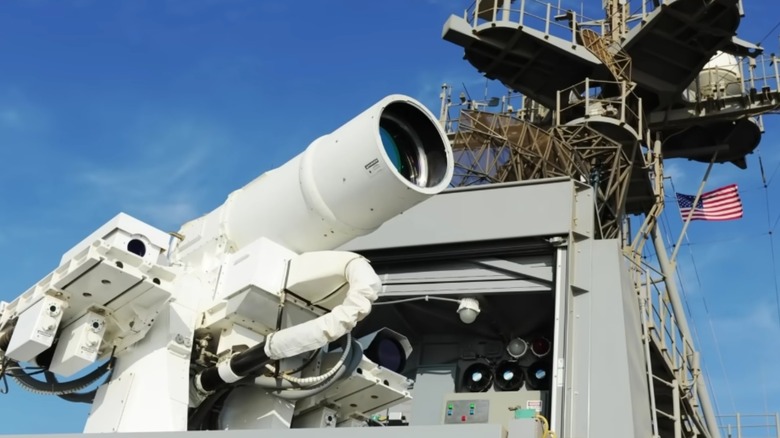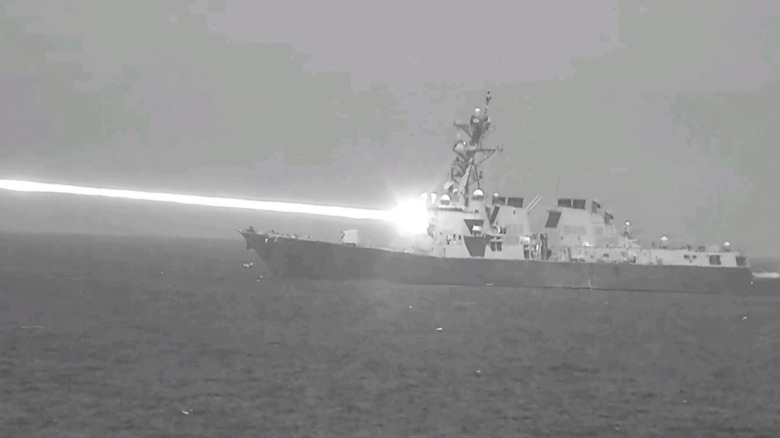China Has A New Laser Weapon It Claims Beats The US Navy's - Here's What It's For
One of the most prominent weapons in modern day warfare is the drone. Small, agile, and often numerous, drones are a difficult assault to counter. Even individual ones can infiltrate areas that heavily armed aircraft or soldiers certainly couldn't. As a result, advanced defenses and anti-drone tech are of vital importance for military forces. At a Victory Day parade in China in September 2025, the world caught a glimpse of the Liaoyuan-1, a new laser weapon for just such a purpose that is intended to be wielded by ships in China's navy.
The Liaoyuan-1 was mounted on an HZ141, a hefty transporter with eight wheels, and showcased at the parade. The Ordnance Industry Science Technology journal (via the South China Morning Post) said that this new weapon was designed for "close-range interception of incoming missiles and drones," suggesting that it is not primarily a weapon to be used offensively but, rather, an additional option for sailors to have at their disposal should other defensive measures fail.
Other nations such as the United States also wield such weapons, which work by means of directed energy and could prove to be a cost-effective way to counter a wide array of battlefield threats. Radio and infrared sensors are believed to help the mysterious weapon target its laser, the aperture of which is claimed by the Chinese to be double that of its U.S. counterpart, HELIOS (pictured here). China does have one important advantage over the United States when it comes to the two naval forces' aircraft carriers, but it isn't yet clear whether a more sophisticated laser weapon and defense system could be another. Even so, technology like this represents another step toward advancements in defenses against the threat of drones and missiles.
Comparing the Liaoyuan-1 and the United States' Helios laser system
The Liaoyuan-1 is similar in concept to the U.S. HELIOS system, which manufacturer Lockheed Martin describes as an Integrated Weapon System. Its catchy and apt acronym stands for High Energy Laser with Integrated Optical-dazzler and Surveillance. The optical dazzler, in particular, is part of what sets it apart. This dazzler technology, which flashes light to temporarily confuse the operator of a drone or its guidance/targeting systems, is one potential way that tanks may be able to counter drones. In February 2020, the USS Dewey received the U.S. Navy's first Optical Dazzling Interdictor system for just this purpose.
Even if the target is an unarmed drone being used for intelligence-gathering purposes, taking its camera out of action by disorienting it with a flash can effectively nullify the drone's purpose entirely. Operating in this way, rather than requiring a weapon to be fired to outright destroy an opposing drone, can be highly cost-effective. This is true not only in the case of drones, but also for targeting missiles and similar threats, too.
Of course, some laser weapons can destroy the targets they need to as well. In the United Kingdom, for instance, a system known as DragonFire is in development. It engages targets at the speed of light and underwent its historical first firing in January 2024. Firing the weapon costs approximately £10 (just under $13.50), which is far cheaper than firing many types of missiles to counter a potential threat. As a broad comparison, Military Strategy Magazine notes that "using Tamir interceptors fired from the Iron Dome to interdict a crude rocket — which can be launched for as little as $1,000 — costs between $40,000 and $80,000 per interception."
Other nations are also developing similar laser weaponry
At present, it's impossible to verify whether China's design outperforms the U.S. Navy's Helios. Particular capabilities of military technology are often classified information, and the Chinese military does not often make such details public. It does appear clear, however, that laser weapons in general have a lot of potential utility against some rising battlefield threats.
A system operating at the speed of light has an enormous advantage, and any means of speeding up a potential interception of a threat could make the difference between success and failure in thwarting its attack. A lot of innovative means of countering the threat of drones have been devised, including the Ukrainian "flying shotgun" drone that has had success in hunting down Russian UAVs. The potential effectiveness of this light-based strategy is reflected in the number of nations who are experimenting with it. This doesn't mean that the technology doesn't have its flaws, though, as there are pitfalls such as blooming (when the focus of a laser beam gets impacted and distorted by environmental disturbances). These are factors that the world's militaries will surely prioritize tackling as these systems continue to develop.
Of course, the world can hope that the United States' HELIOS system and China's Liaoyuan-1 are never engaged in active combat. The two systems are indicative, though, of the fact that both nations are going to great lengths to expand their advanced laser technology. They certainly aren't the only ones, either, as the potent British DragonFire technology helps illustrate.


